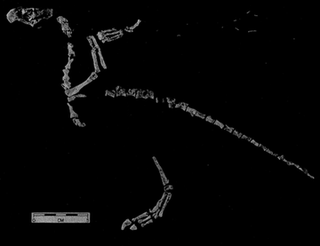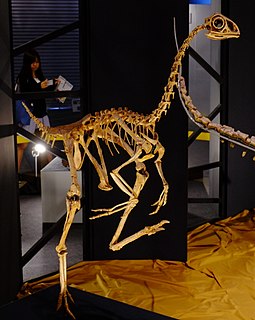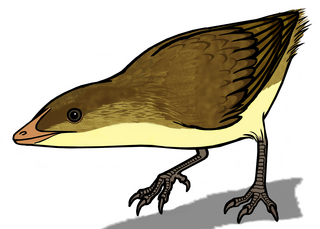History
The term "Proavis" was first coined, although under the form "Pro-Aves", by English osteologist and zoologist William Plane Pycraft in "The Origin of Birds", a 1906 article published in the magazine Knowledge and Scientific News. [1] Pycraft added to his article his own drawn depiction of the hypothetical animal, a restoration entitled "One of the Pro-Aves". Pycraft's "Pro-Avis" (singular of "Pro-Aves") was arboreal, as suggested Professor Osborn six years before, in 1900, in an article dealing with the hypothetical common ancestors of dinosaurs and birds. [2] [3] Pycraft assumed that birds had developed as tree-dwelling dinosaurs, gliding on membranes between the limbs and the trunk. These membranes would gradually have been covered by increasingly more elongated scales, which eventually would have evolved into feathers.
A year after Pycraft's article, the Hungarian aristocrat and paleontologist Franz Nopcsa, who, while residing at London, had seen Pycraft's restoration, drew his own vision of the animal, a picture and article [4] published in a 1907 issue of the Proceedings of the Zoological Society of London (an English science publication nowadays known as Journal of Zoology). But this time, for his own "Pro-Avis" restoration, Nopcsa suggested a cursorial origin, not arboreal. The "Pro-Avis" would thus have been a running animal, accelerating and prolonging its jumps by flapping with feathered forelimbs. There is a model of Nopcsa's restoration, still preserved, and recently restored, in the Grant Museum of Zoology, [5] the only remaining university zoological museum in London. [6]
When Pycraft published his book A History of Birds, in 1910, he reinserted his 1906 restoration One of the Pro-Aves (in page 39). [7] In the following years, as of 1913, Danish artist and amateur zoologist Gerhard Heilmann also used and popularised the term Proavis, this time presenting the public with more accurate and anatomically probable drawings. Heilmann favoured a scientific model in which the assumed Proavis was arboreal and of thecodontian descent, thus not a dinosaur.
In 1961, Czech paleontologist Josef Augusta included "Proavis" in his book Prehistoric Birds and Reptiles. The animal illustration, as were all illustrations in the book, was painted by Zdeněk Burian. [8]
During the 1970s the work of John Ostrom, breathing new life into the hypothesis that birds were dinosaurs, revived the interest in the direct ancestors of birds. Ostrom assumed these were cursorial. An illustration of a running dinosaur explicitly indicated as a "Proavis" was in 1976 published by Dieter Stefan Peters. [9]
In 1991 and 1996 "proavis" or "protoavis" models were proposed by respectively Samuel Tarsitano [10] and Alan Feduccia, [11] both adherents of the "thecodont" hypothesis about the origins of birds. These "proaves" were supposed to be arboreal, with short necks, long trunks, sprawling legs, non-elongated hindlimbs, small hands and feet, small general size, and gliding on membranes. Feduccia's "protoavis" had membranes on the forelimbs only and was fashioned on the model of Megalancosaurus . [11]
The term Proavis was used again in 1999, when Joseph Garner, Graham Taylor, and Adrian Thomas proposed their "pouncing proavis model", an hypothesis entailing that the origin of avian flight rested in a predatory behaviour, the "proavis" jumping on its prey from trees (see pouncing proavis model in Origin of avian flight). [12]
In his 2002 book Dinosaurs of the Air, Gregory S. Paul tried to conceptually model a "pro-avian". In his view the direct ancestors of birds cannot have been completely arboreal, because in that case they would probably have used membranes to fly. He thought they must have represented an intermediate ecological stage, in which the hindlimbs still had largely cursorial adaptations whereas the arms had been elongated in order to climb. Feathers, originally serving the insulation of an already warm-blooded animal, would by elongation have turned the arms into wings in order to fly. More generally, the proavians would, in view of their basal theropod forebears and bird descendants, have been typified by long necks, a short trunk, long fingers with opposable digits, a decoupling of the locomotor functions of the forelimbs and hindlimbs, a lack of a propatagium, a shallow tail, and a weight of about one kilogramme. Paul illustrated his analysis with a skeletal diagram, accompanied by a life illustration of a "proavis". [13] When in 2013 Aurornis was described, at the time the most basal known member of the Avialae, the group consisting of birds and their closest relatives, the Italian paleontologist Andrea Cau remarked it bore an uncanny resemblance to Paul's "proavis". [14]

Archaeopteryx, sometimes referred to by its German name, "Urvogel", is a genus of bird-like dinosaurs. The name derives from the ancient Greek ἀρχαῖος (archaīos), meaning "ancient", and πτέρυξ (ptéryx), meaning "feather" or "wing". Between the late 19th century and the early 21st century, Archaeopteryx was generally accepted by palaeontologists and popular reference books as the oldest known bird. Older potential avialans have since been identified, including Anchiornis, Xiaotingia, and Aurornis.

Caudipteryx is a genus of peacock-sized theropod dinosaurs that lived in the Aptian age of the early Cretaceous. They were feathered and extremely birdlike in their overall appearance, to the point that some paleontologists think it was a bird. Two species have been described: C. zoui, in 1998, and C. dongi, in 2000.

Protoavis is a problematic taxon known from fragmentary remains from Late Triassic Norian stage deposits near Post, Texas. Much controversy remains over the animal, and there are many different interpretations of what Protoavis actually is. When it was first described, the fossils were described as being from a primitive bird which, if the identification is valid, would push back avian origins some 60-75 million years.

Microraptor is a genus of small, four-winged dromaeosaurid dinosaurs. Numerous well-preserved fossil specimens have been recovered from Liaoning, China. They date from the early Cretaceous Jiufotang Formation, 125 to 120 million years ago. Three species have been named, though further study has suggested that all of them represent variation in a single species, which is properly called M. zhaoianus. Cryptovolans, initially described as another four-winged dinosaur, is usually considered to be a synonym of Microraptor.

Bird flight is the primary mode of locomotion used by most bird species in which birds take off and fly. Flight assists birds with feeding, breeding, avoiding predators, and migrating.

The patagium is a membranous structure that assists an animal in gliding or flight. The structure is found in living and extinct groups of animals including bats, birds, some dromaeosaurs, pterosaurs, gliding mammals, some flying lizards, and flying frogs. The patagium that stretches between an animal's hind limbs is called the uropatagium or the interfemoral membrane.

Avimimus, meaning "bird mimic", is a genus of oviraptorosaurian theropod dinosaur, named for its bird-like characteristics, that lived in the late Cretaceous in what is now Mongolia, around 85 to 70 million years ago.

Scansoriopteryx is a genus of maniraptoran dinosaur. Described from only a single juvenile fossil specimen found in Liaoning, China, Scansoriopteryx is a sparrow-sized animal that shows adaptations in the foot indicating an arboreal (tree-dwelling) lifestyle. It possessed an unusual, elongated third finger which may have supported a membranous wing, much like the related Yi qi. The type specimen of Scansoriopteryx also contains the fossilized impression of feathers.

The evolution of birds began in the Jurassic Period, with the earliest birds derived from a clade of theropod dinosaurs named Paraves. Birds are categorized as a biological class, Aves. For more than a century, the small theropod dinosaur Archaeopteryx lithographica from the Late Jurassic period was considered to have been the earliest bird. Modern phylogenies place birds in the dinosaur clade Theropoda. According to the current consensus, Aves and a sister group, the order Crocodilia, together are the sole living members of an unranked reptile clade, the Archosauria. Four distinct lineages of bird survived the Cretaceous–Paleogene extinction event 66 million years ago, giving rise to ostriches and relatives (Paleognathae), ducks and relatives (Anseriformes), ground-living fowl (Galliformes), and "modern birds" (Neoaves).

The scientific question of within which larger group of animals birds evolved has traditionally been called the "origin of birds." The present scientific consensus is that birds are a group of maniraptoran theropod dinosaurs that originated during the Mesozoic Era.

Around 350 BCE, Aristotle and other philosophers of the time attempted to explain the aerodynamics of avian flight. Even after the discovery of the ancestral bird Archaeopteryx which lived over 150 million years ago, debates still persist regarding the evolution of flight. There are three leading hypotheses pertaining to avian flight: Pouncing Proavis model, Cursorial model, and Arboreal model.

John Alan Feduccia is a paleornithologist specializing in the origins and phylogeny of birds. He is S. K. Heninger Distinguished Professor Emeritus at the University of North Carolina. Feduccia's authored works include three major books, The Age of Birds, The Origin and Evolution of Birds, Riddle of the Feathered Dragons, and many peer-reviewed papers in ornithological and biological journals.

Gerhard Heilmann was a Danish artist and paleontologist who created artistic depictions of Archaeopteryx, Proavis and other early bird relatives apart from writing the 1926 book The Origin of Birds, a pioneering and influential account of bird evolution. Heilmann lacked a formal training in science although he studied medicine briefly before shifting to art. His ideas on bird evolution were first written in Danish in the Dansk Ornitologisk Tidsskrift. Heilmann received little help and often got considerable opposition from Danish professional zoologists of the time and he in turn often made dismissive remarks on the ideas of some of the established scientists of the time. The English edition however reached out to a much larger audience and influenced ideas in bird evolution for nearly half a century.

Eoalulavis is a monotypic genus of enantiornithean bird that lived during the Barremian, in the Lower Cretaceous around 125 million years ago. The only known species is Eoalulavis hoyasi.

Sinornis is a genus of enantiornithean birds from the Lower Cretaceous Jiufotang Formation of the People's Republic of China.
The temporal paradox, or time problem is a controversial issue in the evolutionary relationships of birds. It was described by paleornithologist Alan Feduccia in 1994. It reflects a conflict between where chronologically fossils are expected to be found based on a proposed phylogeny, and where they are actually found. The temporal paradox can give rise to alternative phylogenies . Statistical measures have been devised to assess the likelihood of proposed phylogenies based on the size and positioning of gaps in the fossil record.

Praeornis is a dubious genus of early avialan or bird-like dinosaur, named on the basis of a single feather discovered in the Karabastau Formation of Kazakhstan by Sharov in 1971. A second specimen was discovered in 2010 by Dzik et al. The feathers of Praeornis likely represent modified tail feathers used for display or balance, similar to those found in some other early avialans. The feathers of Praeornis are unique thanks to their extremely thick central quill (rachis) and stiffened barbs.

Xiaotingia is a genus of anchiornithid theropod dinosaur from Middle Jurassic or early Late Jurassic deposits of western Liaoning, China, containing a single species, Xiaotingia zhengi.

Aurornis is an extinct genus of anchiornithid theropod dinosaurs from the Jurassic period of China. The genus Aurornis contains a single known species, Aurornis xui. Aurornis xui may be the most basal ("primitive") avialan dinosaur known to date, and it is one of the earliest avialans found to date. The fossil evidence for the animal pre-dates that of Archaeopteryx lithographica, often considered the earliest bird species, by about 10 million years.

The Origin of Birds is an early synopsis of bird evolution written in 1926 by Gerhard Heilmann, a Danish artist and amateur zoologist. The book was born from a series of articles published between 1913 and 1916 in Danish, and although republished as a book it received mainly criticism from established scientists and got little attention within Denmark. The English edition of 1926, however, became highly influential at the time due to the breadth of evidence synthesized as well as the artwork used to support its arguments. It was considered the last word on the subject of bird evolution for several decades after its publication.






















